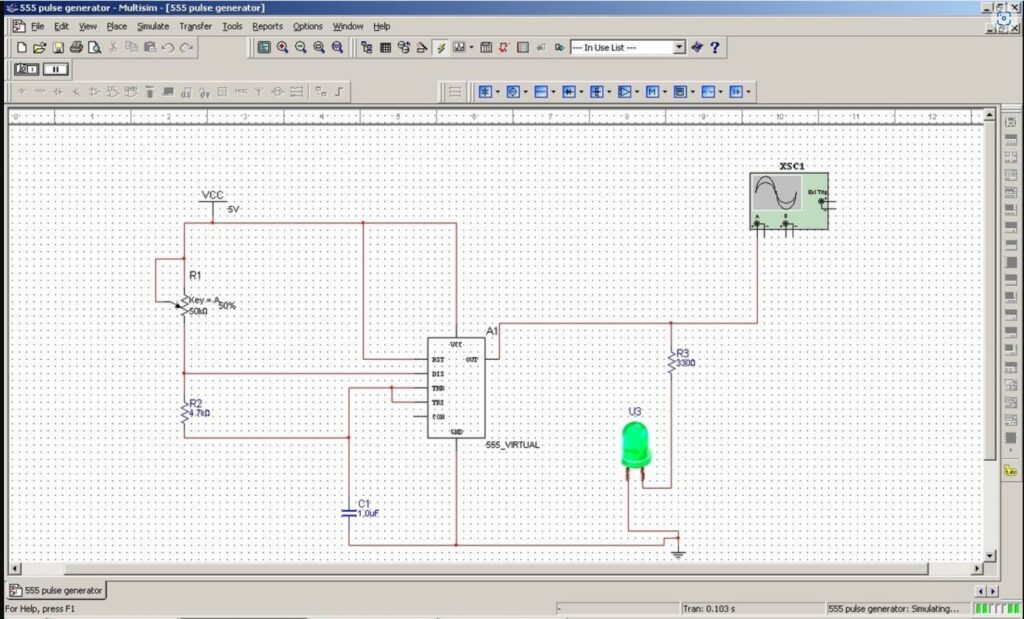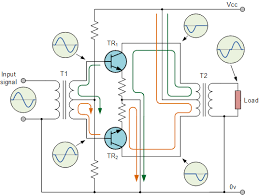In the world of audio amplification, Class D and Class AB amplifiers are among the most commonly discussed and used types. Each has its unique characteristics, advantages, and disadvantages, making them suitable for different applications. This article delves into the key differences between Class D and Class AB amplifiers, exploring their design principles, efficiency, sound quality, and applications.
1. Introduction to Amplifier Classes
Amplifiers are categorized into different classes based on their design architecture and operation. These classes primarily include A, B, AB, C, D, G, and H, each with its distinct mode of operation. Among these, Class AB and Class D amplifiers are widely used due to their balance between efficiency and sound quality.
There are extensive educational content including circuit diagrams, block diagrams, and waveforms of each of the above classes within our website, so please please click underneath each class to be directed to the right article for more details.
2. Operating Principles
- Class AB Amplifier:
- Design and Operation:
- Class AB amplifiers combine the features of Class A and Class B amplifiers. In a Class AB amplifier, each output device conducts more than half but less than the entire input signal cycle, thereby improving efficiency over Class A while reducing the distortion found in Class B designs.
- Biasing: Class AB amplifiers are biased so that both transistors (or other active devices) conduct during a small portion of the signal cycle, typically at the zero-crossing point. This approach helps reduce the crossover distortion that is prominent in pure Class B designs.
- Linear Amplification: These amplifiers operate in a linear fashion, meaning they amplify the input signal directly to produce an output signal that is a larger replica of the input, with minimal alteration.
- Class D Amplifier:
- Design and Operation:
- Class D amplifiers, also known as switching amplifiers, operate by rapidly switching the output devices on and off, producing a pulse-width modulated (PWM) signal. This PWM signal is then passed through a low-pass filter to reconstruct the analog output signal.
- Efficiency: The high efficiency of Class D amplifiers is due to their switching nature, which ensures that the output devices are either fully on or fully off during operation, minimizing the time spent in the linear region where power loss occurs.
- Digital Amplification: Class D amplifiers are often referred to as “digital” amplifiers, though this is somewhat of a misnomer. The input signal is converted into a series of high-speed pulses that represent the signal’s amplitude, rather than a direct digital signal.
For details of the operation principles of each of the above classes, please go to here for class AB and here for class D where you will find a comprehensive article with diagrams and waveforms of each class in full detail.
3. Efficiency
- Class AB Efficiency:
- Class AB amplifiers are more efficient than Class A amplifiers but less efficient than Class D amplifiers. Their efficiency typically ranges from 50% to 70%, depending on the design and operating conditions. The power loss in Class AB amplifiers primarily occurs during the overlap period when both transistors are conducting.
- Class D Efficiency:
- Class D amplifiers are known for their exceptional efficiency, often exceeding 90%. The key to their high efficiency is the reduced time spent in the linear region by the output devices, minimizing power dissipation. This makes Class D amplifiers ideal for portable devices, battery-powered systems, and high-power applications where efficiency is critical.
4. Sound Quality
- Class AB Sound Quality:
- Class AB amplifiers are renowned for their sound quality, offering a good balance between low distortion and efficiency. They are often used in high-fidelity audio systems, where sound quality is paramount. The linear operation of Class AB amplifiers ensures that the amplified signal closely resembles the original input signal, with minimal coloration or distortion.
- Class D Sound Quality:
- Class D amplifiers have historically been criticized for their sound quality, particularly in the early days of the technology. However, advancements in design, component quality, and digital signal processing have significantly improved their audio performance. Modern Class D amplifiers can rival Class AB amplifiers in terms of sound quality, especially at higher power levels, where their efficiency becomes a significant advantage.
5. Thermal Management
- Class AB Thermal Considerations:
- Due to their lower efficiency, Class AB amplifiers generate more heat than Class D amplifiers. This heat must be managed to ensure reliable operation and prevent thermal runaway. As a result, Class AB amplifiers often require larger heat sinks or active cooling solutions, particularly in high-power applications.
- Class D Thermal Considerations:
- The high efficiency of Class D amplifiers means they generate much less heat compared to Class AB amplifiers. This reduced heat generation allows for more compact designs, lighter weight, and less demanding cooling requirements. These characteristics make Class D amplifiers highly suitable for portable and space-constrained applications.
6. Applications
- Class AB Applications:
- Class AB amplifiers are widely used in applications where sound quality is the primary concern. These include high-fidelity audio systems, professional audio equipment, home theater systems, and musical instrument amplifiers. Their ability to deliver low-distortion, high-quality audio makes them the preferred choice for audiophiles and professionals.
- Class D Applications:
- Class D amplifiers are commonly found in applications where efficiency, compactness, and power are crucial. These include portable audio devices, car audio systems, public address systems, subwoofers, and even some high-end home audio systems. The high efficiency of Class D amplifiers also makes them ideal for battery-powered devices and energy-conscious applications.
7. Cost and Complexity
- Class AB Cost and Complexity:
- Class AB amplifiers tend to be simpler in design compared to Class D amplifiers, resulting in lower manufacturing costs. However, the need for larger heat sinks and more robust power supplies can increase the overall cost, especially in high-power designs. The simplicity of Class AB amplifiers also makes them easier to design and implement, which can be an advantage in certain applications.
- Class D Cost and Complexity:
- Class D amplifiers are more complex to design and manufacture due to the need for precise control of the switching process and effective filtering of the PWM signal. However, the reduced cooling requirements and the potential for integration into compact, all-in-one solutions can offset these complexities. In recent years, advancements in semiconductor technology and digital processing have driven down the cost of Class D amplifiers, making them increasingly competitive with Class AB designs.
Here’s a quick overview of what we’ve gone through so far, before we delve into waveforms.
Both Class AB and Class D amplifiers have their strengths and weaknesses, making them suitable for different applications. Class AB amplifiers are often preferred in high-fidelity audio systems where sound quality is paramount, while Class D amplifiers excel in applications where efficiency, power, and compactness are crucial.
Understanding the differences between these two amplifier classes is essential for selecting the right amplifier for your specific needs, whether you prioritize sound quality, efficiency, or a balance of both. As technology continues to advance, the gap between Class AB and Class D amplifiers in terms of sound quality is narrowing, making the choice between them more about application-specific requirements than inherent performance limitations.
The key differences between Class AB and Class D amplifiers can be clearly understood by examining their waveforms and how these waveforms relate to their operation.
1. Waveform Shape and Operation
Class AB Amplifier:
- Waveform Shape:
- The output waveform of a Class AB amplifier closely resembles the input signal. If the input is a sine wave, the output will also be a sine wave, only amplified in amplitude. This is because Class AB amplifiers operate in a linear mode.
- Both the positive and negative halves of the waveform are amplified, but the amplification process is not perfectly linear across the entire waveform. The transition around the zero-crossing point (where the waveform switches from positive to negative or vice versa) can introduce a small amount of crossover distortion.
- How It Works:
- Analog Amplification: In Class AB amplifiers, the input signal is fed into a pair of transistors (or other active devices) that work together to amplify the signal.
- Biasing: These transistors are biased so that one transistor conducts slightly during the positive half of the waveform, and the other conducts during the negative half. There is a small overlap where both transistors are conducting at the same time, which helps reduce the crossover distortion found in Class B amplifiers.
- Continuous Operation: The transistors operate continuously in their linear region (not fully on or off), which allows them to reproduce the waveform with high fidelity.
Class D Amplifier:
- Waveform Shape:
- The output waveform of a Class D amplifier is fundamentally different from that of a Class AB amplifier. Instead of a continuous analog waveform, the output consists of a high-frequency pulse-width modulated (PWM) signal.
- The PWM waveform switches rapidly between high and low states (essentially digital on-off states), representing the amplitude of the input signal through the duty cycle (the proportion of the time the signal is “on”).
- This PWM signal is later passed through a low-pass filter to remove the high-frequency components, reconstructing the original analog signal, which resembles the input waveform.
- How It Works:
- Switching Amplification: Class D amplifiers work by converting the input analog signal into a series of high-frequency pulses. This conversion is done using a modulator that generates a PWM signal based on the input signal’s amplitude.
- Rapid Switching: The output transistors in a Class D amplifier are either fully on or fully off, switching at a frequency much higher than the audio range (typically several hundred kHz). This high-speed switching minimizes power loss because the transistors spend little time in the transition region where they would dissipate the most power.
- Filtering: After the PWM signal is generated, it is passed through a low-pass filter that smooths out the high-frequency components, effectively reconstructing the original analog waveform that drives the speaker.
2. Visual Representation of Waveforms
- Class AB Amplifier:
- Imagine a smooth sine wave on an oscilloscope. The output of a Class AB amplifier closely mirrors this sine wave, with the peaks corresponding to the loudest parts of the audio signal and the troughs corresponding to the quietest parts.
- Near the zero-crossing points, there may be slight irregularities (due to crossover distortion), but the waveform remains fundamentally sinusoidal.
- Class D Amplifier:
- The output before filtering is a square wave or a series of rectangular pulses on an oscilloscope. The pulse width changes dynamically, corresponding to the input signal’s amplitude. For example, when the input signal is at its peak, the pulses are wider, and when the input signal is at a low amplitude, the pulses are narrower.
- After passing through a low-pass filter, the high-frequency switching components are removed, leaving a smooth waveform that resembles the original sine wave input.
The following is a representative of a class AB waveform, the majority positive waves are the output of the NPN transistor and the majority negative waves are the output waves of PNP transistor, which together will result in a full smooth Sine wave.
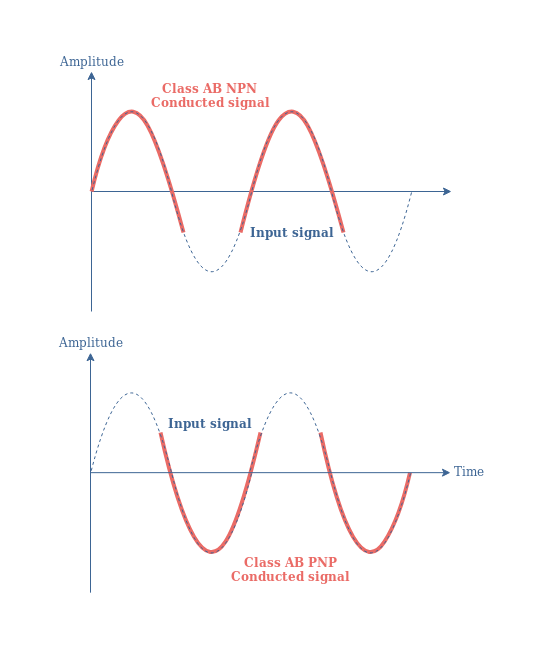
Whereas the following is the representation of a class D amplifier waveforms:
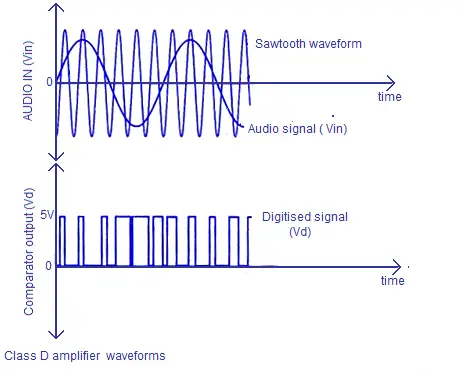
3. Practical Implications of Waveform Differences
- Efficiency:
- The continuous waveform of the Class AB amplifier results in more heat being generated because the transistors are always conducting, even if only partially. This leads to lower efficiency, typically between 50-70%.
- The pulsed nature of the Class D waveform allows for much higher efficiency, often exceeding 90%, because the transistors are either fully on (minimizing voltage drop) or fully off (minimizing current flow).
- Sound Quality:
- The linear amplification of Class AB ensures high-fidelity sound reproduction, making it ideal for applications where sound quality is critical.
- Class D amplifiers, while initially associated with lower sound quality, have improved significantly. Modern filtering techniques and advancements in PWM control have made Class D amplifiers capable of delivering sound quality comparable to Class AB, especially at higher power levels.
Conclusion
The waveform shapes and operational principles of Class AB and Class D amplifiers are fundamentally different, reflecting their unique strengths and weaknesses. Class AB amplifiers maintain a continuous analog waveform that closely matches the input signal, offering excellent sound quality at the expense of efficiency. In contrast, Class D amplifiers operate using high-frequency pulse-width modulation, providing high efficiency and compactness while also being capable of delivering high-quality audio with the right design and filtering. Understanding these differences is crucial when selecting an amplifier for specific audio applications.
Ready to take a dive into Electrical Engineering to get a head start on College or University, or simply expand your DIY knowledge?
Check out our meticulously designed course in Electrical/Electronic Engineering for all walks of life, from any country. Delivered by Professor F. Tavassoli.
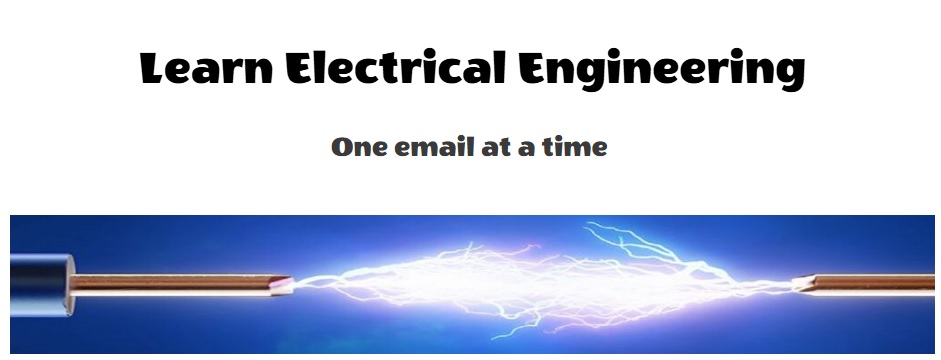
Join students and professionals
from across the world increasing their knowledge of Electrical Engineering.
One email at a time
We never send spam or give your information to anyone, Privacy Policy here.

